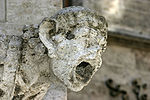Carbonic acid
| Carbonic acid | |
|---|---|
 
| |
| General | |
| Systematic name | dimethyl carbonate |
| Other names | carbon dioxide solution |
| Molecular formula | H2CO3 |
| SMILES | c(=o)(o)o |
| Molar mass | Molar mass::275.74 |
| Appearance | a white solid |
| CAS number | CAS number::463-79-6 |
| Properties | |
| Density and phase | Density::1 g/ml |
| Solubility in water | insolubule |
| Melting point | Melting point::210°C |
| Boiling point | Boiling point::-78°C |
| Acidity (pKa) | 6.36 |
| Related compounds | |
| Related compounds | Biphenyl carbonic acid |
| Except where noted otherwise, data are given for materials in their standard state (at 25 °C, 100 kPa) Disclaimer and references | |
Carbonic acid is an inorganic acid and found mostly in liquids. It can only exist as a solution and it has a white color to it when in water. It is made from mostly carbon dioxide and it is not a very strong acid. You can find it in soda pop and many other things. It is corrosive on limestone and calcium, which causes many caves to form over a period of time as it eats away at the rock. It is a weak acid that is used in a few industries and it comes in a gas. It gives carbonated beverages a sharp taste. It is insoluble in water and it's chemical formula is H2CO3. It's systematic name is dimethyl carbonate and the other name for it is carbon dioxide solution. Carbonic acid's ancient names were 'acid of the air' and 'aerial acid'.
History
Carbonic acid was first discovered in the Pyrmont Water by Dr.Brownrigg and carbonic acid gas was first discovered by Dr.Black, in 1757. Then it was named carbonic acid in 1785. In 1867, Joseph Lister, a surgeon at the Glasgow Royal Infirmary, he found that carbonic acid when applied a open wound after surgery, it acted as an antiseptic, killing the bacteria that would form around the area that had been opened up.
Properties
Carbonic acid is formed when carbon dioxide is dissolved in water and can only exist in a solution. It is a weak, unstable dibasic acid and that forms carbonate and bicarbonate salts. Carbonic acid can gives two series of salts: carbonate and hydrogen carbonate salt. Carbonic acid dissolves rocks, metals, minerals, and it can form caves. Carbonic acid's acidity is 6.36 pK, it's boiling point is at -78 C, and it's melting point is 210 C. Its molar mass is 275.74g and it's CAS number is 463-79-6.
Occurrences
Carbonic acid occurs in the blood, rain water, calcite, fermentation, coal, ground water, meteors, volcanoes, amino acids, proteins, oceans, plants, erythrocytes, sulfur deposits, salts, and caves.
Uses
Carbonic acid has many uses, for example, fertilizer, soda pop, as a gas in the medical field, pharmaceutical, cosmetics, oil shale, food processing aid, medical, anaesthetic, fuel, industrial, salts, lasers, bottling, contact lens cleaner, engines, therapeutic, hydrolysis of starch, drugs, and welding.
Acid Rain and the Ocean
Acid rain or normal rain has dissolved carbonic acid in it has a pH of 4.5 to 5.6. The carbonic acid in the ocean is increasing, causing many animals, like plankton, to die and is corroding to shells and coral. The acid rain falls and drains into the ocean making it have more acid than it has had previously. The ocean is at a pH of 8.1, which is about 0.1 lower than at the beginning of the Industrial Revolution. Acid rain with the carbonic acid reacts with the calcium carbonate in the marble statues and buildings to form a soluble calcium hydrogen carbonate, slowly destroying them. The carbon dioxide comes out of cars or factories and into the air mixing with the rain water to form carbonic acid. It then drains into the ocean where it causes damage to sea life.
References
| ||||||||||||||


